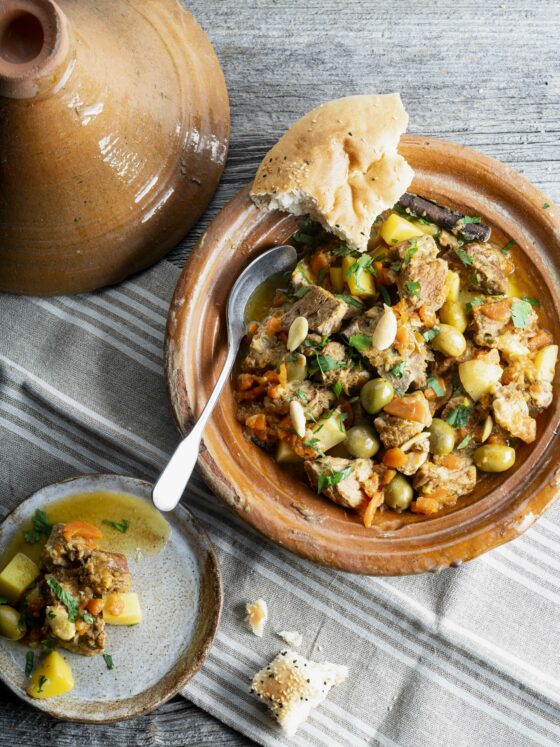Veal tagine with carrots, almonds and saffron
Moroccan cuisine is full of amazing recipes, and the tagine is definitely one of the most iconic. This fragrant, aromatic stew is traditionally prepared in an earthenware dish with a pointed, conical lid. Tajines are incredibly versatile and can be made with meat, fish or vegetables. Today, we're going to make veal tagine, a dish that exudes warmth and cosiness. But first, let’s dive into the rich history, the unique preparation method and the delicious ingredients that make this dish so special. Get ready for a culinary journey full of tradition and flavour!
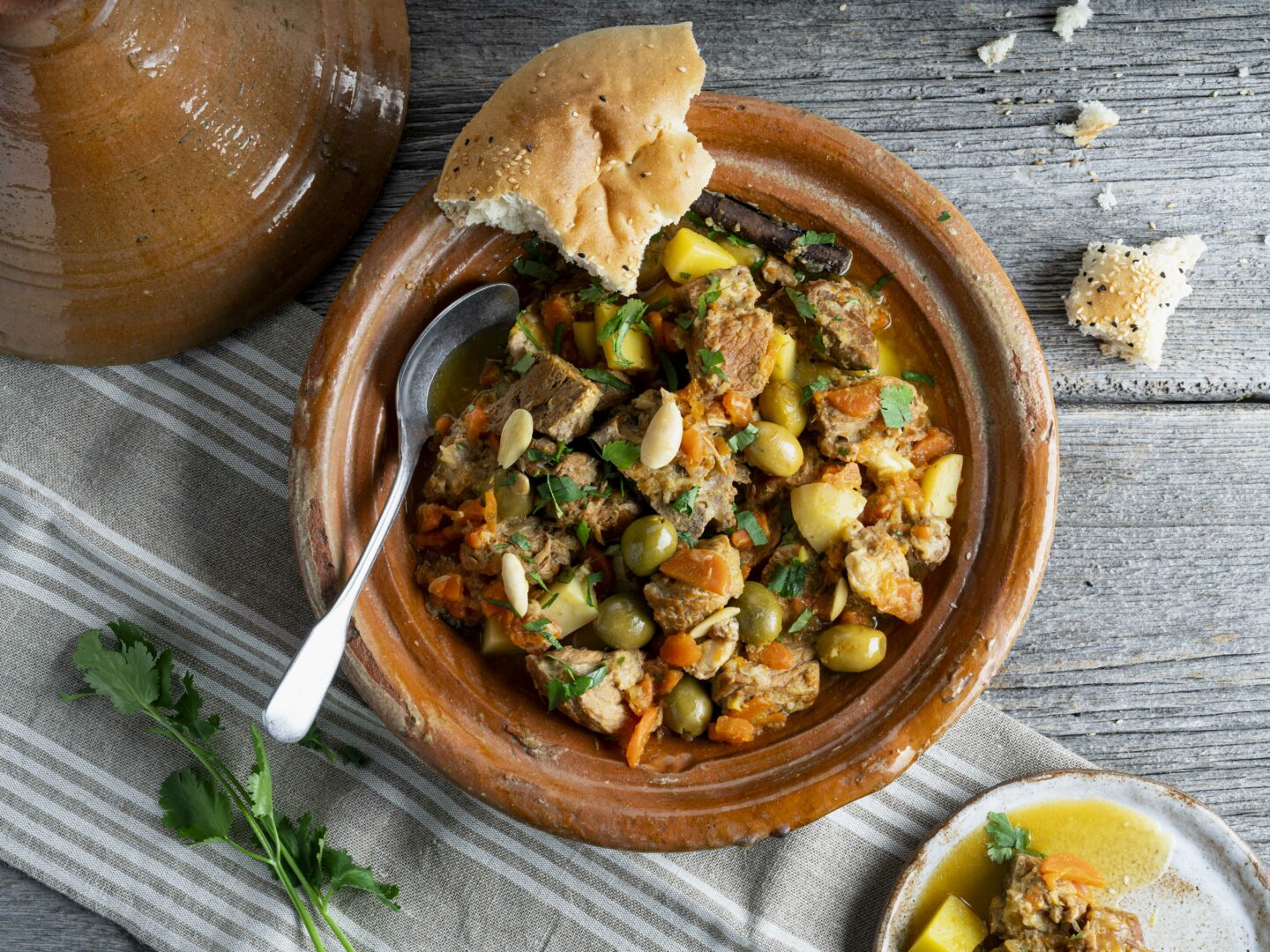
The origin of tagine
The tagine is an important part of cuisines in Morocco, Tunisia and Algeria. This famous cookware first appeared with the Berbers, the indigenous nomads of North Africa. Centuries ago, the Berbers used the distinctive tagine to cook easily and efficiently over an open wood fire. Thanks to its specific shape, they could make a delicious meal of tender stewed meat even in difficult conditions. Tagines were adopted across the region, with each area creating its own version of the dish. The Arabs introduced spices like cinnamon, ginger and cumin, which became a key part of tagine cooking. These days, everyone loves a good tagine. You'll find it on the menu in restaurants worldwide as a signature dish of Moroccan cuisine.
What is a tagine?
The word tagine refers to both the dish itself and the earthenware vessel in which the dish is prepared.
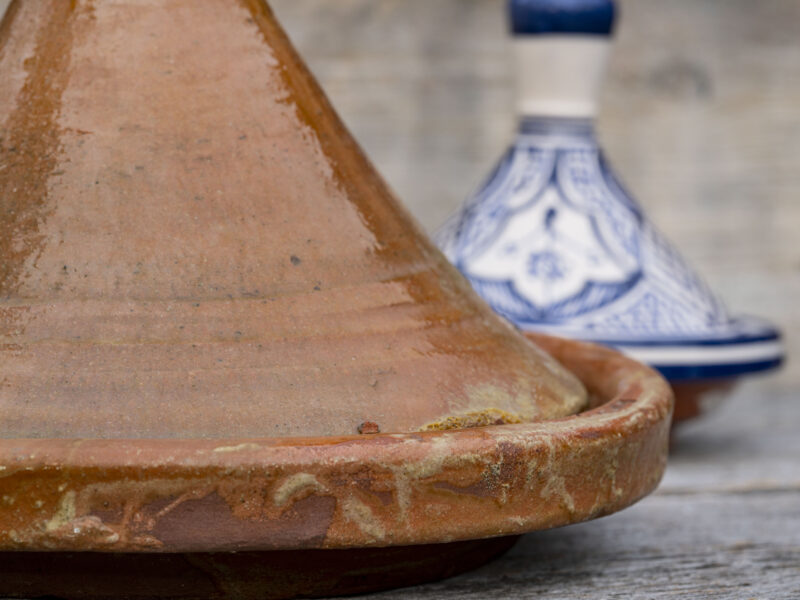
Tajine, a unique dish
Tajine is a Moroccan stew that is made with meat, fish or vegetables and lots of aromatic spices. The secret to a perfect tagine is to simmer the meat slowly until it's incredibly tender. This ultimate slow-cooking dish is full of rich flavours and has a velvety sauce.
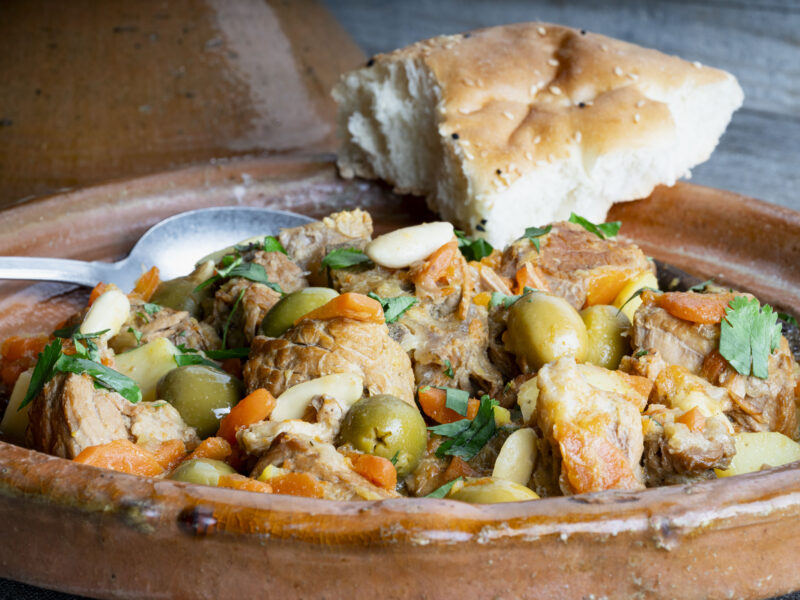
The typical ingredients
Tajines are a really versatile meal and can be made with a whole range of ingredients. Here are a few of the most common ones:
- Meat: commonly used meats are chicken, lamb, veal and beef. But you can also make tagine with fish.
- Vegetables: potatoes, carrots, tomatoes, courgettes, onions and bell peppers are the most popular vegetables.
- Spices: cinnamon, saffron, ginger, cumin, turmeric and ras-el-hanout give tagines their distinctive flavour.
- Dried fruits: add plums, dates, apricots or raisins for a delicious sweet and savoury combination.
- Nuts and pulses: almonds and pine nuts add texture. Chickpeas are a common ingredient in vegetarian tagines.
- Extra flavour: green olives and preserved lemons give a salty and sour flavour. Fresh herbs such as coriander, parsley and mint add a fresh touch to the dish.
The classic tagines
One of the great classics is tagine with lamb, prunes and almonds. Another popular choice is chicken tagine with olives and candied lemons, or fish tagine with ginger and tomatoes. Onions are an essential ingredient in almost all tagines. They form the basis for the aromatic, thickened sauce, deghmira, which is created during the cooking process. Modern Moroccan cuisine features countless variations of tagine, which are often adapted to the seasons.
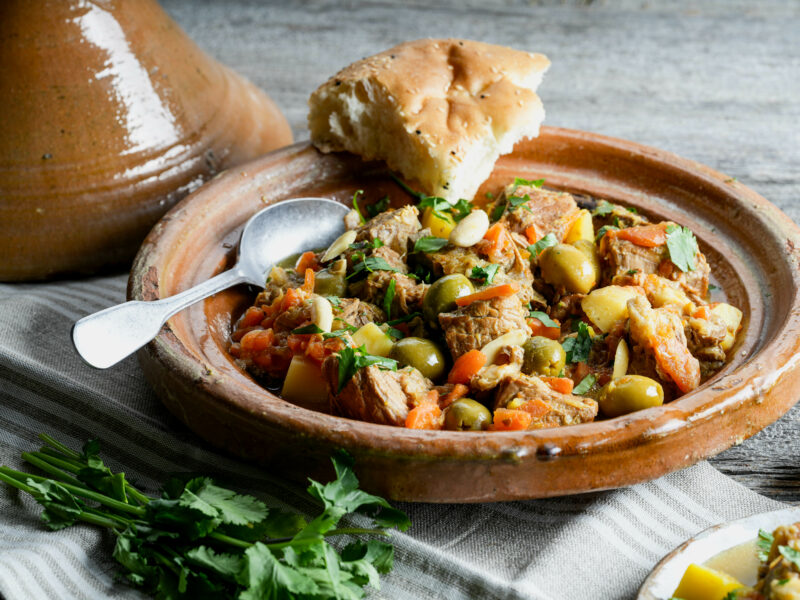
The four types of tagines
There are four types of tagines, depending on the type of fat and seasoning used.
- The yellow tagine: the yellow tagine gets its colour from turmeric and saffron. The dish is made with olive oil and also contains ginger.
- The brown tagine: brown tagine is prepared with butter, paprika and cumin.
- Chermoula tagine: in a chermoula tagine, a marinade is made with olive oil, lemon, garlic and various spices.
- Tomato tagine: in this tagine you will find tomatoes, olive oil, garlic, paprika, cumin and fresh spices.
Modern tagines, playing around with flavours
The tagine is the perfect dish for letting your imagination run wild. Here are some combinations worth trying:
- Vegetarian tagine: combine young artichokes with potatoes, peas and fresh herbs like parsley, coriander and mint.
- Spicy kefta (meatballs): add sweet onions, bell peppers and spices such as cinnamon, pepper, cumin, ginger and saffron.
- Quail instead of chicken: prepared with grapes and ginger or with dates, cinnamon and almonds.
- Lamb: delicious with peas, tomatoes, peppers and mint.
The possibilities are endless!
What to eat with tagine
Tajine is usually served with soft flatbread, which is great for dipping in the tasty, aromatic sauce. Often, a fresh salad is also served with it. You can also choose to have couscous or quinoa with a tagine.
A unique cooking pot
A tagine is a special cooking pot made up of two parts: an earthenware bowl and a tall, conical lid. Sometimes the lid and the inside of the bowl are glazed. The conical shape of the lid catches the vapour created in the dish and condenses it, so you hardly need to add any moisture to the preparation. This makes the meat and vegetables incredibly tender and gives them a really intense flavour.
Types of tagines
Tajines come in all sizes, from single-person tajines to huge bowls in which you can prepare a dish for 15 people. Traditional tagines are made of rough earthenware, but these days you'll also find them made of cast iron or aluminium. Then, there are the richly decorated tagines that you can't use for cooking – you use those as serving dishes.
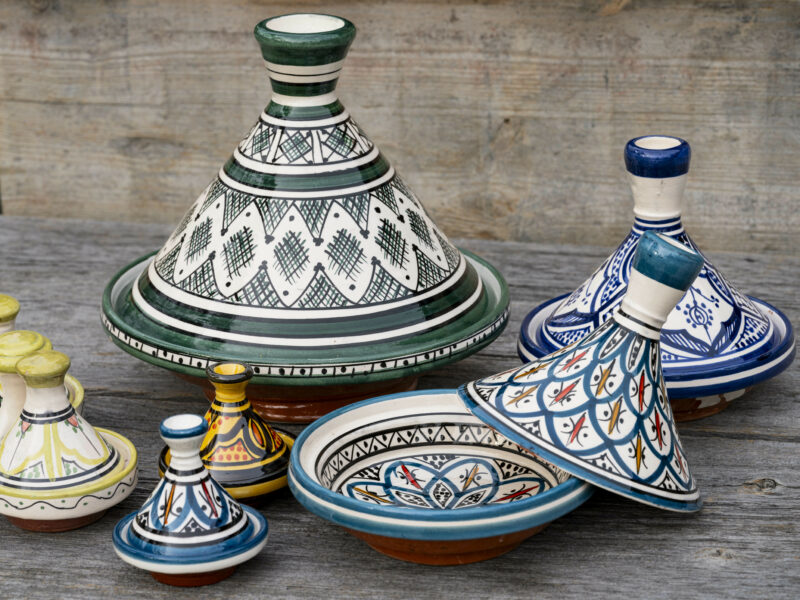
Getting the best out of your tagine
With these handy tips, you can enjoy your tagine for years to come:
- Preparation: Before using your tagine for the first time, season it. Rub the unglazed part of the tajine with a garlic clove. Fill the dish with water and add 50 ml of olive oil, a chopped onion, two cloves of garlic, 4 carrots cut into pieces and a bay leaf. Close with the lid and put in an oven at 150°C for 45 minutes. Let the tagine cool in the oven and clean.
- Usage: You can put an earthenware tagine over the flame of a gas cooker or barbecue and also in the oven. For electric, ceramic and induction cooktops, it is best to use a thermal distributor.
- Cooking: Only use a tagine over a low flame and avoid large temperature fluctuations.
- Cleaning: Clean the tagine with a soft brush or sponge. Metal scrapers damage the glaze, and detergents can leave a bad taste.
- Drying: Let the dish and lid of the tagine dry separately on a rack to prevent the formation of mould.
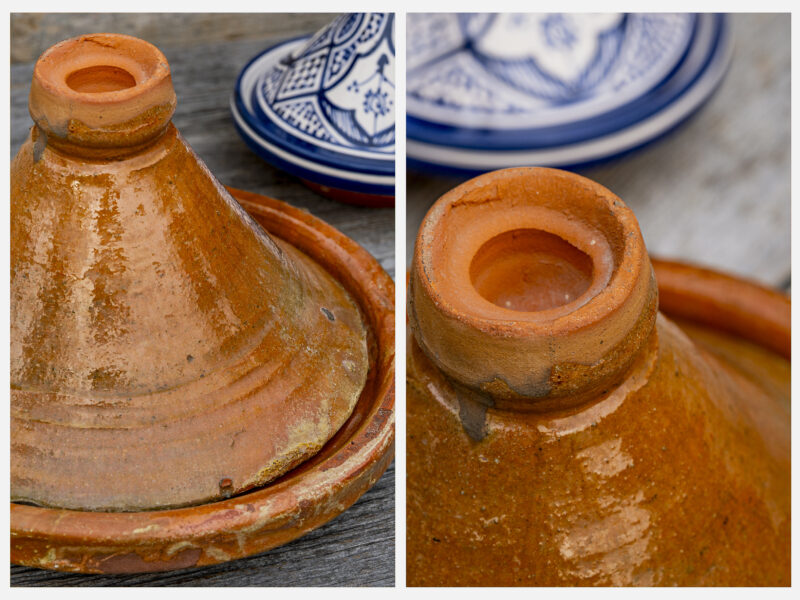
Recipe: veal tagine with carrots, almonds and saffron
You'll need a tagine for this recipe, but if you don't have one, you can use an earthenware or cast-iron cooking pot instead.
To make the most of the flavour, choose a cut of veal breast that still has the bone in it. Just ask your butcher to cut the bone and slice the meat into 3 to 4 cm cubes.
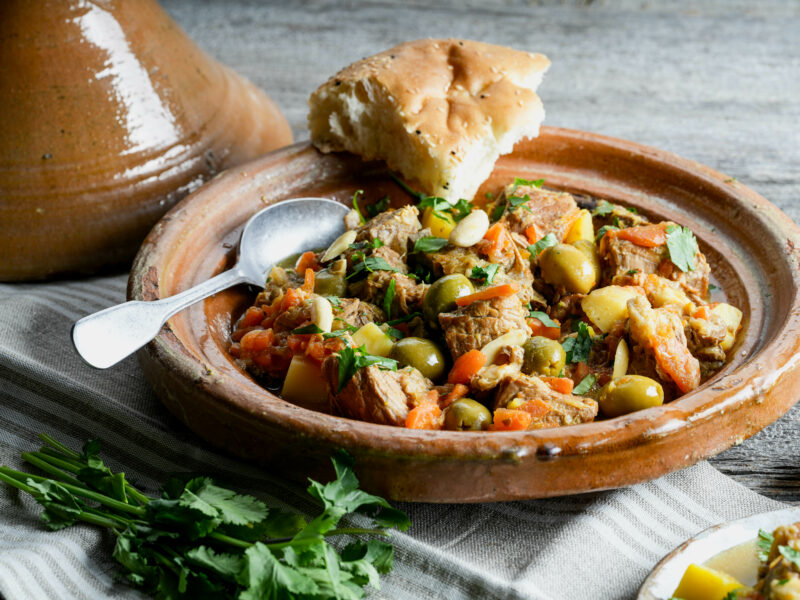
Ingredients for 4 people:
- 1 kg bone-in veal breast, cut into cubes
- 2 tablespoons of olive oil
- 2 onions
- 3 cloves of garlic
- 2 large carrots
- 3 waxy potatoes
- 150 ml veal stock
- 1 cinnamon stick
- 1 tablespoon grated ginger
- 1 teaspoon ground cumin
- 12 green olives
- 12 peeled almonds
- 1 pinch of saffron threads
- 1 pinch of sugar
- Pepper and salt
- 2 tablespoons chopped parsley
- 2 tablespoons chopped coriander
-
Step 1: Preparation
Chop the onions and garlic into fine slices. Dice the carrots and cut the potatoes in large chunks. Rub the saffron with the sugar to powder in a mortar and dissolve the powder in a tablespoon of warm water.
-
Step 2: Prepare the tagine
Heat the oil in the dish of the tagine over medium-high heat. Fry the meat for a few minutes, then add the cinnamon stick and sprinkle with cumin. Season with salt and pepper, then mix well. Now add the onions, garlic and ginger and simmer for five minutes. Add the carrots and veal stock, cover with the lid, bring to the boil and turn the heat down low. Simmer for one and a half hours, then add the potatoes and continue to simmer. When the meat and potatoes are soft, add the saffron, olives and almonds and simmer gently for another 5 minutes.
-
Step 3: Serve
Spoon the veal tagine into a preheated dish and sprinkle with parsley and coriander. Serve with Moroccan bread or ciabatta and a crispy salad.
![Tajine 00147]()
